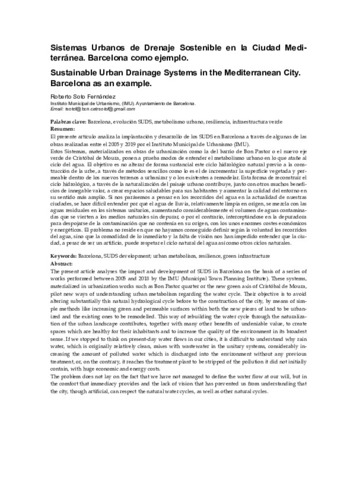Mostra el registre d'ítem simple
Sistemas Urbanos de Drenaje Sostenible en la Ciudad Mediterránea: Barcelona como ejemplo
| dc.contributor.author | Soto Fernández, Roberto |
| dc.coverage.spatial | east=2.1770085; north=41.3829253; name=C. del Bisbe, 2, 08002 Barcelona, Espanya |
| dc.date.accessioned | 2020-09-03T10:39:29Z |
| dc.date.available | 2020-09-27T00:27:54Z |
| dc.date.issued | 2020-09-28 |
| dc.identifier.citation | Soto Fernández, R. Sistemas Urbanos de Drenaje Sostenible en la Ciudad Mediterránea: Barcelona como ejemplo. A: Llop, C.; Cervera, M.; Peremiquel, F. (eds.). "IV Congreso ISUF-H: Metrópolis en recomposición: prospectivas proyectuales en el Siglo XXI: Forma urbis y territorios metropolitanos, Barcelona, 28-30 Septiembre 2020". Barcelona: DUOT, UPC, 2020, p. 1-10. ISBN 978-84-9880-841-4. |
| dc.identifier.isbn | 978-84-9880-841-4 |
| dc.identifier.uri | http://hdl.handle.net/2117/328341 |
| dc.description.abstract | El presente artículo analiza la implantación y desarrollo de los SUDS en Barcelona a través de algunas de las obras realizadas entre el 2005 y 2019 por el Instituto Municipal de Urbanismo (IMU). Estos Sistemas, materializados en obras de urbanización como la del barrio de Bon Pastor o el nuevo eje verde de Cristóbal de Moura, ponen a prueba modos de entender el metabolismo urbano en lo que atañe al ciclo del agua. El objetivo es no alterar de forma sustancial este ciclo hidrológico natural previo a la construcción de la urbe, a través de métodos sencillos como lo es el de incrementar la superficie vegetada y permeable dentro de los nuevos terrenos a urbanizar y o los existentes a remodelar. Esta forma de reconstruir el ciclo hidrológico, a través de la naturalización del paisaje urbano contribuye, junto con otros muchos beneficios de innegable valor, a crear espacios saludables para sus habitantes y aumentar la calidad del entorno en su sentido más amplio. Si nos parásemos a pensar en los recorridos del agua en la actualidad de nuestras ciudades, se hace difícil entender por qué el agua de lluvia, relativamente limpia en origen, se mezcla con las aguas residuales en los sistemas unitarios, aumentando considerablemente el volumen de aguas contaminadas que se vierten a los medios naturales sin depurar, o por el contrario, interceptándose en la depuradora para despojarse de la contaminación que no contenía en su origen, con los unos enormes costes económicos y energéticos. El problema no reside en que no hayamos conseguido definir según la voluntad los recorridos del agua, sino que la comodidad de lo inmediato y la falta de visión nos han impedido entender que la ciudad, a pesar de ser un artificio, puede respetar el ciclo natural del agua así como otros ciclos naturales. |
| dc.description.abstract | The present article analyses the impact and development of SUDS in Barcelona on the basis of a series of works performed between 2005 and 2018 by the IMU (Municipal Town Planning Institute). These systems, materialized in urbanization works such as Bon Pastor quarter or the new green axis of Cristóbal de Moura, pilot new ways of understanding urban metabolism regarding the water cycle. Their objective is to avoid altering substantially this natural hydrological cycle before to the construction of the city, by means of simple methods like increasing green and permeable surfaces within both the new pieces of land to be urbanized and the existing ones to be remodelled. This way of rebuilding the water cycle through the naturalization of the urban landscape contributes, together with many other benefits of undeniable value, to create spaces which are healthy for their inhabitants and to increase the quality of the environment in its broadest sense. If we stopped to think on present-day water flows in our cities, it is difficult to understand why rain water, which is originally relatively clean, mixes with wastewater in the unitary systems, considerably increasing the amount of polluted water which is discharged into the environment without any previous treatment, or, on the contrary, it reaches the treatment plant to be stripped of the pollution it did not initially contain, with huge economic and energy costs. The problem does not lay on the fact that we have not managed to define the water flow at our will, but in the comfort that immediacy provides and the lack of vision that has prevented us from understanding that the city, though artificial, can respect the natural water cycles, as well as other natural cycles. |
| dc.format.extent | 10 p. |
| dc.language.iso | spa |
| dc.publisher | DUOT, UPC |
| dc.relation.uri | http://hdl.handle.net/2117/331479 |
| dc.rights | Attribution-NonCommercial-NoDerivs 3.0 Spain |
| dc.rights.uri | http://creativecommons.org/licenses/by-nc-nd/3.0/es/ |
| dc.subject | Àrees temàtiques de la UPC::Urbanisme |
| dc.subject | Àrees temàtiques de la UPC::Desenvolupament humà i sostenible |
| dc.subject.lcsh | Sewage -- Spain -- Barcelona |
| dc.subject.lcsh | Sustainable development -- Spain -- Barcelona |
| dc.subject.other | Barcelona |
| dc.subject.other | Evolución SUDS |
| dc.subject.other | Metabolismo urbano |
| dc.subject.other | Resiliencia |
| dc.subject.other | Infraestructura verde |
| dc.subject.other | SUDS development |
| dc.subject.other | Urban metabolism |
| dc.subject.other | Resilience |
| dc.subject.other | Green infrastructure |
| dc.title | Sistemas Urbanos de Drenaje Sostenible en la Ciudad Mediterránea: Barcelona como ejemplo |
| dc.title.alternative | Sustainable Urban Drainage Systems in the Mediterranean City: Barcelona as an example |
| dc.type | Conference report |
| dc.subject.lemac | Aigües residuals -- Catalunya -- Barcelona |
| dc.subject.lemac | Desenvolupament sostenible -- Catalunya -- Barcelona |
| dc.rights.access | Open Access |
| local.citation.contributor | Llop, C.; Cervera, M.; Peremiquel, F. (eds.) |
| local.citation.pubplace | Barcelona |
| local.citation.publicationName | IV Congreso ISUF-H: Metrópolis en recomposición: prospectivas proyectuales en el Siglo XXI: Forma urbis y territorios metropolitanos, Barcelona, 28-30 Septiembre 2020 |
| local.citation.startingPage | 1 |
| local.citation.endingPage | 10 |


